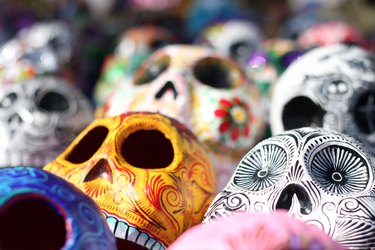
Day of the Dead, or Dia de los Muertos, festivals commonly are celebrated in Latin American countries as well as other Spanish-speaking countries. The celebration focuses on family members who have died. Families gather and build altars for loved ones. They also deliver gifts to the grave site. The holiday is similar to All Saints' Day and All Souls' Day, which Christians celebrate in November. The Day of the Dead is celebrated from October 31 through November 2 each year.
North America
Video of the Day
Mexicans have been celebrating the Day of the Dead for centuries. The festival originates from an Aztec festival celebrated for the "Lady of the Dead," a goddess for the dead. Aztecs kept the skulls of their enemies as trophies and displayed them during a ritual performed in the ninth month of the Aztec calendar. The modern festival has a day dedicated to deceased children and one day for a celebration of adults. Day of the Dead is not a recognized federal holiday in the United States but many western states celebrate the holiday. Arizona and Texas have large populations of Mexican Americans who honor this holiday with traditional events such as wearing masks and outfits in a parade through the streets.
Video of the Day
Central America
Guatemala has a large celebration honoring the dead. Residents visit the graves of dead ancestors and fly large kites to top off the celebration. The festival concludes with a feast of fiambre traditionally made only during this celebration. Fiambre is a cold salad made with 50 different ingredients including sausage, onions and olives grown within the country.
South America
Day of the Dead celebrations are common in all societies of Ecuador, especially within the Kichwa population, which make up more than 25 percent of the country's residents. Food is taken to the graves of ancestors to honor their spirits. The food usually is a spiced fruit porridge mixed with purple maize. The porridge is eaten on a bread called "guaguas de pan." Brazilians celebrate place flowers and candles on graves of their deceased ancestors. Family members say prayers over the graves for the spirits of the ancestors. The celebration is a happy, positive festival in honor of the dead. No special parades or food are part of the celebration in Brazil, and residents only celebrate on November 2. Bolivia has a large Day of the Dead celebration. The Andean population of the country began honoring the bones of their ancestors three years after their deaths. Today, the Day of the Dead celebration only uses the skull of one family member. The skull is kept inside the house throughout the year to protect the family. The celebration occurs when the family decorates the skull with flowers, clothing and other items to thank the skull for protecting the family.
Caribbean
Haiti has a very large Day of the Dead celebration. The culture's voodoo traditions mix with Catholic observances to honor the dead. Residents go to the cemeteries and play loud drums all night to waken a god named Baron Samedi. The music also wakens Baron Samedi's mischievous family members so the gods can carry the souls of the dead to the afterlife.